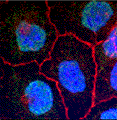Biochemistry, Department of
Document Type
Article
Date of this Version
4-7-2009
Abstract
The CO2-concentrating mechanism (CCM) of Chlamydomonas reinhardtii and other microalgal species is essential for photosynthetic growth in most natural settings. A great deal has been learned regarding the CCM in cyanobacteria, including identification of inorganic carbon (Ci; CO2 and HCO3−) transporters; however, specific knowledge of analogous transporters has remained elusive in eukaryotic microalgae such as C. reinhardtii. Here we investigated whether the limiting-CO2–inducible, putative ABC-type transporter HLA3 might function as a HCO3− transporter by evaluating the effect of pH on growth, photosynthetic Ci affinity, and [14C]-Ci uptake in very low CO2 conditions following RNA interference (RNAi) knockdown of HLA3 mRNA levels in wild-type and mutant cells. Although knockdown of HLA3 mRNA alone resulted in only modest but high-pH–dependent decreases in photosynthetic Ci affinity and Ci uptake, the combination of nearly complete knockdown of HLA3 mRNA with mutations in LCIB (which encodes limiting-Ci–inducible plastid-localized protein required for normal Ci uptake or accumulation in low- CO2 conditions) and/or simultaneous, apparently off-target knockdown of LCIA mRNA (which encodes limiting-Ci–inducible plastid envelope protein reported to transport HCO3−) resulted in dramatic decreases in growth, Ci uptake, and photosynthetic Ci affinity, especially at pH 9, at which HCO3− is the predominant form of available Ci. Collectively, the data presented here provide compelling evidence that HLA3 is directly or indirectly involved in HCO3− transport, along with additional evidence supporting a role for LCIA in chloroplast envelope HCO3− transport and a role for LCIB in chloroplast Ci accumulation.



Comments
Published in Proceedings of the National Academy of Sciences U.S.A. 106:14 (April 7, 2009), pp. 5990-5995; doi 10.1073/pnas.0812885106 Copyright © 2009 National Academy of Sciences U.S.A. Used by permission.